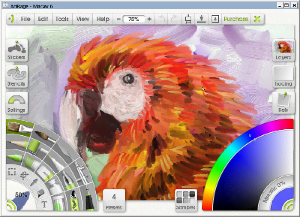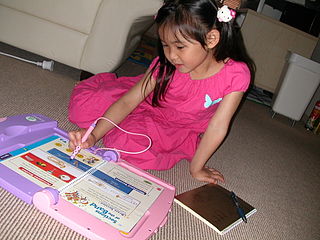
A graphics tablet is a computer input device that enables a user to hand-draw images, animations and graphics, with a special pen-like stylus, similar to the way a person draws images with a pencil and paper. These tablets may also be used to capture data or handwritten signatures. It can also be used to trace an image from a piece of paper that is taped or otherwise secured to the tablet surface. Capturing data in this way, by tracing or entering the corners of linear polylines or shapes, is called digitizing.

ViewSonic Corporation is a Taiwanese-American privately held multinational electronics company with headquarters in Brea, California, United States and a research & development center in New Taipei City, Taiwan.

ArtRage is a bitmap graphics editor for digital painting created by Ambient Design Ltd. It is currently in version 6, and supports Windows, macOS and mobile Apple and Android devices and is available in multiple languages. It caters to all ages and skill levels, from children to professional artists. ArtRage 5 was announced for January 2017 and finally released in February 2017.

InFocus Corporation is an American privately owned company based in the state of Oregon. Founded in 1986, the company develops, manufactures, and distributes DLP and LCD projectors and accessories as well as large-format touch displays, software, LED televisions, tablets and smartphones. InFocus also offers video calling services. Formerly a NASDAQ listed public company, InFocus was purchased by Image Holdings Corp., owned by John Hui, in 2009 and is now a wholly owned subsidiary headquartered in Tigard, Oregon.
Synaptics is a publicly owned San Jose, California-based developer of human interface (HMI) hardware and software, including touchpads for computer laptops; touch, display driver, and fingerprint biometrics technology for smartphones; and touch, video and far-field voice technology for smart home devices and automotives. Synaptics sells its products to original equipment manufacturers (OEMs) and display manufacturers.

LeapPad is a range of tablet computers developed for children. Various models of the LeapPad have been developed since 1999.

Interactive media normally refers to products and services on digital computer-based systems which respond to the user's actions by presenting content such as text, moving image, animation, video and audio.

An interactive whiteboard (IWB), also known as interactive board or smart board, is a large interactive display board in the form factor of a whiteboard. It can either be a standalone touchscreen computer used independently to perform tasks and operations, or a connectable apparatus used as a touchpad to control computers from a projector. They are used in a variety of settings, including classrooms at all levels of education, in corporate board rooms and work groups, in training rooms for professional sports coaching, in broadcasting studios, and others.
Technology integration is the use of technology tools in general content areas in education in order to allow students to apply computer and technology skills to learning and problem-solving. Generally speaking, the curriculum drives the use of technology and not vice versa. Technology integration is defined as the use of technology to enhance and support the educational environment. Technology integration in the classroom can also support classroom instruction by creating opportunities for students to complete assignments on the computer rather than with normal pencil and paper. In a larger sense, technology integration can also refer to the use of an integration platform and APIs in the management of a school, to integrate disparate SaaS applications, databases, and programs used by an educational institution so that their data can be shared in real-time across all systems on campus, thus supporting students' education by improving data quality and access for faculty and staff.
"Curriculum integration with the use of technology involves the infusion of technology as a tool to enhance the learning in a content area or multidisciplinary setting... Effective integration of technology is achieved when students are able to select technology tools to help them obtain information in a timely manner, analyze and synthesize the information, and present it professionally to an authentic audience. The technology should become an integral part of how the classroom functions—as accessible as all other classroom tools. The focus in each lesson or unit is the curriculum outcome, not the technology."

A tablet computer, commonly shortened to tablet, is a mobile device, typically with a mobile operating system and touchscreen display processing circuitry, and a rechargeable battery in a single, thin and flat package. Tablets, being computers, do what other personal computers do, but lack some input/output (I/O) abilities that others have. Modern tablets largely resemble modern smartphones, the only differences being that tablets are relatively larger than smartphones, with screens 7 inches (18 cm) or larger, measured diagonally, and may not support access to a cellular network.
Audience response is a type of interaction associated with the use of audience response systems, to create interactivity between a presenter and its audience.
EXPO mimio is a brand name of computer whiteboard capture devices marketed by Sanford Brands. EXPO mimio devices allow users to digitally capture whiteboard images and text.

Pen computing refers to any computer user-interface using a pen or stylus and tablet, over input devices such as a keyboard or a mouse.

Edusim is a cave automatic virtual environment "Immersive Touch" 3D natural user interface (NUI)-based concept of lesson driven (multi-user) 3D virtual worlds on the classroom interactive whiteboard or classroom interactive surface. The Edusim concept is demonstrated by the Edusim free and open-source multi-user 3D Open Cobalt virtual world platform and authoring tool kit modified for the classroom interactive whiteboard or surface. The Edusim application is a modified edition of the open source Open Cobalt Project and relies heavily on the affordances of direct manipulation of 3D virtual learning models and constructionist learning principles.

The National Science Foundation supported Mobile Studio Project, or Mobile Studio, is developing pedagogy and hardware/software which, when connected to a PC, provides functionality similar to that of laboratory equipment typically associated with an instrumented studio classroom. The Mobile Studio IOBoard is a small, inexpensive hardware platform for use in a home, classroom or remote environment. When coupled with the Mobile Studio Desktop software, the system duplicates a large amount of the hardware often used to teach Electrical Engineering, Computer Engineering, Control Systems, and Physics courses; among others. With the support of several technology companies and the National Science Foundation, the Mobile Studio Project is now being utilized to enhance science, math, engineering and technology education around the world. The project's goal is to enable hands-on exploration of science and engineering principles, devices, and systems that have historically been restricted to expensive laboratory facilities.
Luidia, Inc. produces portable interactive whiteboard technology for classrooms and conference rooms. Its eBeam hardware and software products work with computers and digital projectors to use existing whiteboard or writing surface as interactive whiteboards.
The history of tablet computers and the associated special operating software is an example of pen computing technology, and thus the development of tablets has deep historical roots. The first patent for a system that recognized handwritten characters by analyzing the handwriting motion was granted in 1914. The first publicly demonstrated system using a tablet and handwriting recognition instead of a keyboard for working with a modern digital computer dates to 1956.
The following outline of Apple Inc. is a topical guide to the consumer electronics, software, retail stores, corporate acquisitions, timeline, and personnel under the purview of the American multinational corporation Apple Inc. The company's best-known hardware products are the Macintosh, the iPod, the iPhone, and the iPad. Its best-known software includes the macOS and iOS operating systems, and the iTunes media browser. As of March 2014, Apple has 425 retail stores in 16 countries, and an online store.
eBeam is an interactive whiteboard system developed by Luidia, Inc. that transforms any standard whiteboard or other surface into an interactive display and writing surface.
Commercial augmented reality (CAR) describes augmented reality (AR) applications that support various B2B (Business-to-Business) and B2C (Business-to-Consumer) commercial activities, particularly for the retail industry. The use of CAR started in 2010 with virtual dressing rooms for E-commerce.











